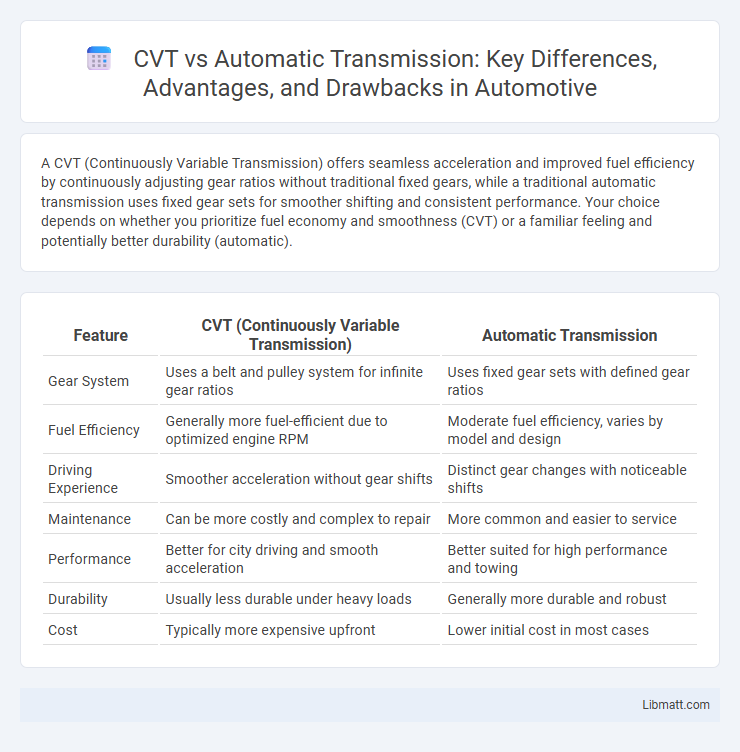A CVT (Continuously Variable Transmission) offers seamless acceleration and improved fuel efficiency by continuously adjusting gear ratios without traditional fixed gears, while a traditional automatic transmission uses fixed gear sets for smoother shifting and consistent performance. Your choice depends on whether you prioritize fuel economy and smoothness (CVT) or a familiar feeling and potentially better durability (automatic).
Table of Comparison
| Feature | CVT (Continuously Variable Transmission) | Automatic Transmission |
|---|---|---|
| Gear System | Uses a belt and pulley system for infinite gear ratios | Uses fixed gear sets with defined gear ratios |
| Fuel Efficiency | Generally more fuel-efficient due to optimized engine RPM | Moderate fuel efficiency, varies by model and design |
| Driving Experience | Smoother acceleration without gear shifts | Distinct gear changes with noticeable shifts |
| Maintenance | Can be more costly and complex to repair | More common and easier to service |
| Performance | Better for city driving and smooth acceleration | Better suited for high performance and towing |
| Durability | Usually less durable under heavy loads | Generally more durable and robust |
| Cost | Typically more expensive upfront | Lower initial cost in most cases |
Introduction to CVT and Automatic Transmissions
Continuously Variable Transmissions (CVTs) utilize a system of pulleys and belts to provide seamless, stepless gear ratios, enhancing fuel efficiency and smooth acceleration. Traditional automatic transmissions rely on fixed gear sets and hydraulic systems to shift between predetermined gears, offering a familiar driving experience with reliable performance. The fundamental distinction lies in CVT's infinite ratio variability versus the conventional stepwise shifting in automatic transmissions.
How CVT Transmissions Work
CVT transmissions use a system of belts and pulleys to provide a seamless range of gear ratios, allowing the engine to operate at its most efficient RPM for varying speeds. Unlike traditional automatic transmissions that shift between fixed gears, CVTs continuously adjust the driving ratio to optimize fuel efficiency and performance. This design results in smoother acceleration and improved fuel economy compared to conventional automatic gearboxes.
How Automatic Transmissions Function
Automatic transmissions use a complex system of planetary gears, hydraulic controls, and torque converters to shift gears smoothly without manual input. Unlike CVTs, which provide seamless variable gear ratios for efficiency, automatic transmissions have fixed gear sets that change based on speed and load. Understanding how automatic transmissions function can help you appreciate their reliability and familiar driving feel compared to CVT systems.
Key Differences Between CVT and Automatic
Continuously Variable Transmission (CVT) uses a belt and pulley system to provide seamless gear ratio changes, resulting in smoother acceleration and improved fuel efficiency compared to traditional automatic transmissions that rely on fixed gear sets. Automatic transmissions utilize planetary gear sets with distinct gear changes, offering more defined shifting feel and generally better performance during high-power applications. CVTs excel in fuel economy and smoothness, while traditional automatics deliver superior durability and responsiveness under heavy load conditions.
Performance Comparison: CVT vs Automatic
CVT (Continuously Variable Transmission) delivers smoother acceleration and improved fuel efficiency by seamlessly adjusting gear ratios, while traditional automatic transmissions offer more predictable power surges and quicker response times during aggressive driving. CVTs excel in urban commuting due to their efficient power delivery, but automatics provide better performance for towing and high-speed scenarios with their fixed gear sets. Understanding these differences helps you choose the transmission that best matches your driving style and performance needs.
Fuel Efficiency: CVT vs Automatic
CVT (Continuously Variable Transmission) often provides superior fuel efficiency compared to traditional automatic transmissions due to its ability to maintain the engine at the optimal RPM for fuel consumption. Automatic transmissions with fixed gear ratios can cause more fuel consumption during acceleration and variable speed conditions. If maximizing your vehicle's fuel economy is a priority, choosing a CVT-equipped model can result in noticeable savings at the pump.
Maintenance and Reliability
CVT transmissions typically require more frequent fluid changes and careful maintenance to avoid premature wear compared to traditional automatic transmissions. Automatic transmissions have a longer track record of reliability with established maintenance intervals, helping to reduce long-term repair costs. Understanding these differences can help you make informed decisions about upkeep and vehicle longevity.
Driving Experience and Comfort
CVT transmissions provide smoother acceleration by eliminating noticeable gear shifts, enhancing your overall driving comfort especially in stop-and-go traffic. Automatic transmissions offer predictable gear changes that some drivers find more engaging and responsive during acceleration or overtaking. Choosing between a CVT and an automatic depends on whether you prioritize seamless driving ease or traditional shifting feedback in your daily driving experience.
Pros and Cons: CVT vs Automatic
CVT transmissions offer smoother acceleration and better fuel efficiency compared to traditional automatic transmissions, which use fixed gear ratios. Automatic transmissions provide more responsive shifting and greater durability under heavy loads but often sacrifice fuel economy due to power losses within the torque converter. While CVTs excel in urban driving efficiency, they may feel less engaging and produce a droning noise, whereas automatics deliver a more familiar driving experience with defined gear shifts.
Which Transmission Is Right for You?
Choosing between a CVT (Continuously Variable Transmission) and a traditional automatic depends on your driving preferences and needs. CVTs offer smooth acceleration and improved fuel efficiency by continuously adjusting gear ratios, making them ideal for city driving and maximizing gas mileage. If you prioritize a more familiar shifting feel and robust performance during highway or heavy-duty driving, a conventional automatic transmission may better suit your lifestyle.
CVT vs automatic Infographic

 libmatt.com
libmatt.com